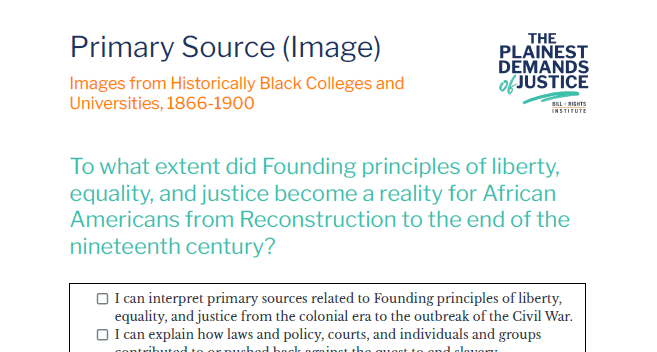Images from Historically Black Colleges and Universities, 1866-1900
Guiding Question: To what extent did Founding principles of liberty, equality, and justice become a reality for African Americans from Reconstruction to the end of the nineteenth century?
- I can interpret primary sources related to Founding principles of liberty, equality, and justice from the colonial era to the outbreak of the Civil War.
- I can explain how laws and policy, courts, and individuals and groups contributed to or pushed back against the quest to end slavery.
- I can create an argument using evidence from primary sources.
- I can analyze issues in history to help find solutions to present-day challenges.
Building Context
After the Civil War, most southern universities banned Black Americans from enrolling or enforced quotas to limit their enrollment. Black Americans in turn established their own universities and colleges, demonstrating the importance and priority given to educating the community. Today, many of these institutions are designated as Historically Black Colleges and Universities (HBCU). These institutions continue to be leading centers of learning and scholarship in the United States today.
Images from Historically Black Colleges and Universities, 1866-1900
Source Links:
Howard University: https://www.loc.gov/resource/stereo.1s07887/
Hampton University: http://loc.gov/pictures/resource/cph.3b10023/ and https://en.wikipedia.org/wiki/Hampton_University#/media/File:Hampton_Institute_-_bricklaying.jpg
Fisk University: http://loc.gov/pictures/resource/cph.3b47387/
Tuskegee: https://www.loc.gov/item/98503043/ (also used in warm-up)
Students on the lawn of Howard University, Washington, DC
Students studying Earth’s rotation around the sun, Hampton Institute, Hampton, Virginia
Students in a bricklaying class, Hampton Institute, Hampton, Virginia
Students in an Extempo (debate) Club, Fisk University, Nashville, Tennessee
History class at Tuskegee Institute, Tuskegee, Alabama
Comprehension and Analysis Questions
- How are these photographs similar? Different?
- How do these photographs support the arguments of Frederick Douglass in his speech on “The Blessings of Liberty and Education” (Document 20) and Booker T. Washington’s Atlanta Exposition Address (Document 21)? Note that Booker T. Washington was principal of the Tuskegee Institute, shown in photograph 5, from its founding in 1881 until his death in 1915.






